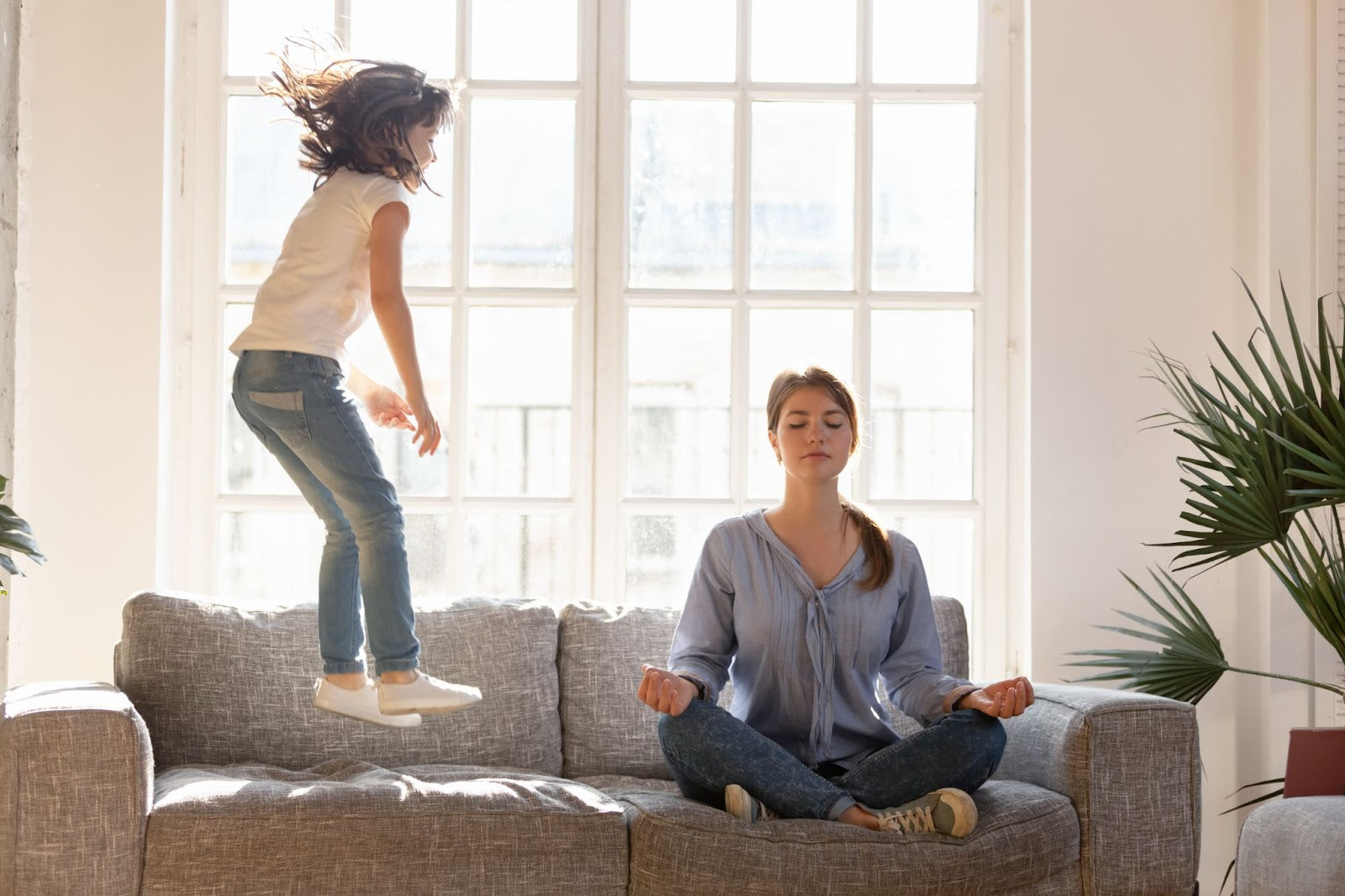Hyperactive children, or those with ADHD, have difficulty concentrating and channeling their energy.
Although hyperactivity affects more than 5% of children, it remains difficult for their parents to know how to support them on a daily basis. Many feel unable to calm their child.
In this article, you will find our 7 tips for calming a hyperactive child at home in order to promote their and your well-being.
Understanding Hyperactivity in Children
A child suffering from hyperactivity has difficulty staying still and concentrating. Unable to channel their energy, their level of nervous excitement is such that they have difficulty calming down.
Although not systematic, hyperactivity is often linked to ADHD (Attention Deficit Hyperactivity Disorder). This neurodivergence impacts daily life and often results in learning difficulties.
Difference between a dynamic child and a hyperactive child
Unlike a dynamic child, a hyperactive child experiences persistent motor restlessness that is accompanied by other disorders, such as attention deficit and impulsivity. They are not only unruly, but also exhibit more extreme and frequent behaviors, which can impact their learning and relationships with others.
|
Features |
Dynamic child |
Hyperactive child (ADHD) |
|
Motor activity |
Moves a lot, but knows when to stop |
Unable to stay still even when the situation demands it |
|
Attention |
Ability to focus on topics of interest |
Easily distracted, difficulty completing a task |
|
Impulsiveness |
Impatient, but aware of social rules |
Interrupts, acts without thinking |
|
Organization |
Able to follow a routine with assistance |
Difficulty organizing one's affairs and following instructions |
|
Evolution with age |
Agitation tends to decrease with age |
Symptoms usually persist into adulthood, although some may improve |
Signs of ADHD in children
From one child to another, the signs of ADHD may vary. However, there are common features:
-
Inattention:
-
Difficulty concentrating on an activity or conversation,
-
Excessive sensitivity to distractions: noise in the street, flies, rays of sunlight, airplanes in the sky, etc.
-
Frequent forgetfulness: personal belongings, homework, instructions, etc.
-
Difficulty organizing work and following instructions,
-
Careless mistakes,
-
Inability to complete a task.
-
Impulsivity:
-
Excessive chatter,
-
Difficulty waiting for your turn,
-
Hasty answers before the end of the questions,
-
Frequent interruptions to other people's conversations or games
-
Lack of risk awareness, constant danger.
-
Restlessness or hyperactivity:
-
Inability to stay still,
-
Untimely getting up in class without permission,
-
Motor overactivity: runs, jumps, climbs even in the most inappropriate situations (in class, at the table, etc.),
-
Difficulty engaging in calm and/or relaxing activities.
7 tips for calming a hyperactive child
As parents, it's common to feel overwhelmed by a hyperactive child. Fortunately, there are meetings and support groups organized by associations and medical and social institutions to meet other parents of hyperactive children and share advice.
To begin, we have compiled 7 essential tips to implement at home to calm your hyperactive child.
Creating a calm and structured environment for a hyperactive child
A calm and structured environment is essential to promote the concentration of your hyperactive child.
To do this, you must compartmentalize the spaces according to the activities with:
-
a quiet space, away from the hustle and bustle of the house, where the child can rest and refocus (reading corner, soft rug, teepee, etc.),
-
an organized and tidy work area for doing homework.
Minimize distractions and excessive sensory stimulation, such as harsh lights (above 300 lux), bright colors, loud noises (above 50 dcbl)... If you cannot control the noise, you can invest in noise-cancelling headphones.
Encourage physical activity to channel energy
Hyperactive children have an increased need to exercise. Exercising can not only help reduce their restlessness and impulsiveness, but also boost their cognitive abilities (memory) and help them sleep better.
Focus on outdoor activities and those that engage attention without seeming to, such as motor skills courses or balance games.
During more studious activities, don't hesitate to give your child regular active breaks. Alternating between static and dynamic activities every 45 minutes prevents sensory overload. As such, it may be worth investing in an active seat, such as our Bloon ball seat.
Establish a stable routine to calm a hyperactive child
A hyperactive child needs a clear framework and visual cues. In addition to structuring the space, it's essential to establish a stable routine with set mealtimes, bedtimes, and wake-up times. We recommend using a visual schedule with a color system.
Create a regular and predictable schedule for your child's day. This helps prevent frustration, anxiety, and distraction. If there's a change in schedule, let your child know as soon as possible to avoid anxiety.
It is difficult for a hyperactive child to stay focused for too long, so it is better to divide activities, especially homework, into small tasks and plan break times.
Practice relaxation and breathing exercises
As shown According to this 1995 study , stressed parents are more likely to have their children suffer from hyperactivity. Children feel the stress, which can affect them and worsen their disorder in the case of hyperactivity or ADHD.
Therefore, when dealing with a hyperactive child, it's essential to learn how to manage their stress. To do this, we recommend practicing relaxation and breathing exercises to help you react more relaxed to your child's behavior.
Don't hesitate to introduce your child to relaxation and breathing exercises to help them calm down.
For example, you can practice simple breathing and mindfulness exercises together. Use a soft, soothing voice to dictate the exercises.
There Meditation , relaxation, and yoga can improve concentration and attention, as well as reduce anxiety, which is particularly beneficial for hyperactive children. They also help build their self-esteem.
Generally speaking, encourage your child to engage in quiet activities, such as drawing, modeling, building games, reading, listening to soft music or audio stories, etc.
Adopt positive and caring communication and attitude
After a long day at work, it's easy to feel overwhelmed. As a result, we tend to raise our voices and reprimand our children.
However, a hyperactive child needs to be encouraged and supported.
Often experiencing academic failure, children with ADHD are more prone to low self-esteem and withdrawal, which can lead to antisocial behavior in adulthood.
This is why it is essential to adopt positive and caring communication and attitude.
Here are some effective ways to encourage your child:
-
Reward their efforts: Emphasize their efforts rather than their results, and prefer to ignore certain behaviors, albeit annoying, but minor. Don't show signs of exasperation and don't punish failures, as this risks increasing their aggression, agitation, and feelings of failure and inferiority. Only intolerable behaviors should be punished.
-
Encourage their talents: Help your child identify their artistic and athletic talents. To celebrate and encourage them to explore their creativity, you could, for example, create a pride wall where you display all their accomplishments.
-
Repeat things kindly even if he repeats the behaviors that annoy you: show empathy and get down to his level to remind him of the rules. Make sure to explain only one instruction at a time.
-
Set realistic and achievable goals with your child and choose motivating rewards.
-
Celebrate successes: For example, each evening, you can invite him to list three positive things he accomplished during the day, establish a simple reward system, or organize regular ceremonies to celebrate his progress.
-
Regularly remind him of your love for him: Having little self-confidence, hyperactive children need to feel loved, supported and understood.
Promote a balanced diet
Diet plays a key role in managing ADHD symptoms, including restlessness.
So, focus on a balanced diet and avoid certain foods that can aggravate hyperactivity, such as:
-
Avoid refined sugars, found in candy, cakes, or sodas. Instead, opt for slow-release sugars found in cereals (without added sugar), bread, or pasta to maintain steady energy levels throughout the day.
-
Artificial colors (E102, E104, etc.) and preservatives: All of these additives, found in processed foods, increase ADHD symptoms. Therefore, opt for homemade meals.
-
Stimulants, such as caffeine.
Also pay attention to nutritional deficiencies. A fortified diet or supplementation with iron, calcium, zinc, or magnesium may be recommended for ADHD.
Ensure quality sleep
Hyperactive children need to get enough restorative sleep.
Here are our tips for improving your hyperactive child's sleep:
-
Create a bedroom conducive to rest: soft colors and lighting, warm materials. For example, a cozy cabin bed can provide a sense of security and comfort.
-
Create an environment conducive to sleep, calm and dark.
-
Establish a daily routine: fixed times for getting up and going to bed.
-
Establish a bedtime ritual (bath, story, night light, etc.).
-
Avoid screens a few hours before bedtime.
To learn more, read our article on sleep and ADHD .
FAQ: Everything about how to calm a hyperactive child
How to calm a hyperactive child naturally?
Calming a hyperactive child naturally relies on a suitable environment, sufficient sleep, a balanced diet, regular exercise, etc.
How to channel an overactive child?
Channeling an overactive child involves physical activity, a suitable diet, relaxation and breathing exercises.
How to make a hyperactive child obey?
To get a hyperactive child to obey, it is important to give only one instruction at a time, formulate the instruction simply, set realistic goals, establish a daily routine, implement positive communication and a reward system.
How to calm a hyperactivity crisis?
In the event of a hyperactivity crisis, you can isolate your child in a quiet place. If this is not enough and he allows it, try wrapping him in your arms.
The best way, however, is to learn how to avoid hyperactivity attacks by identifying and dismantling the triggers of attacks in order to circumvent and prevent them. Communicate with your child about what can put them in this state.
What makes a child hyperactive?
The causes of hyperactivity and ADHD are not clearly identified, but these disorders may stem from genetic and environmental factors.
Why is a child too restless?
A child may become overly agitated when they have difficulty expressing themselves or are worried about a problem at school or a change (moving, loss of a loved one, etc.). Agitation is often triggered by feelings of anxiety.
What are the signs of hyperactivity in children?
The three main signs of hyperactivity in a child are restlessness, impulsiveness, and inattention.












